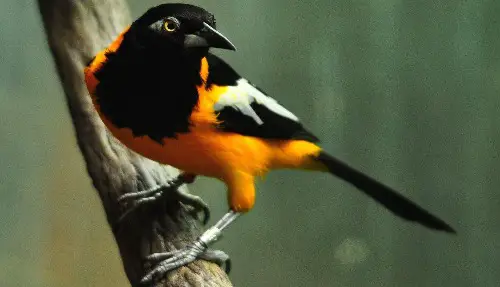The Orange Bird from Walt Disney World is perhaps one of the most famous globally.
But...
We don't want to talk about fictitious characters here. We want to tell you the black and orange bird species you'll see across North America. Let's get started!
Black Bird With Orange Chest, Back, Or Wings: Which Bird Species Are These?
The plumage is one physical characteristic that helps us ID birds. When we combine it with body length, feeding habits, and habitat, we can tell many species apart. Let’s look at the ones with orange feathers in at least one body part.
1. Red-winged Blackbird

This medium-sized bird measures 6.7 to 9.1 inches, so it's smaller than a common grackle. Though smaller than the average 8.3 to 9.1 inches of a northern cardinal, a red-winged bird has a longer wingspan.
The male is a black bird with orange on the wings; thus, it's more colorful than an American crow. The female bird has brown plumage with streaks.
The males fight anyone and anything that shows up in their territory during the breeding season. It doesn't matter if the nest invader is a human being or another bird.
You're likely to see a red-winged blackbird perched on a telephone wire. If you're birding in winter, you'll see blackbirds roosting in millions.
You can spread mixed grains in your backyard as this is a ground-feeding bird. Use a tube or platform feeder to host other birds that don't feed on the ground like this one and still attract the red winged blackbird to your backyard.
2. Baltimore Oriole

Unlike the black plumage of most blackbirds, such as the red winged blackbird above, a Baltimore oriole is a black bird with an orange chest.
You'll only see this medium to long-distance migrant in the eastern region of North America from April to May as that's its breeding range. It then migrates south to winter in Florida and farther to Central and South America.
This fruit-eating bird loves orange slices, so you know what to offer in your feeder.
A Baltimore oriole is about the length of a robin, as it's between 6.7 and 7.5 inches long. It's the state bird of Maryland.
The males are more colorful as they have orange outer tail feathers and rump, plus black backs and heads. The females' have yellow feathers on their tails and brownish or yellowish heads and backs.
You'll find this species in open woodlands and forest edges abundant in deciduous trees. You might have to listen for their wink calls because they love feeding high. But, they also come lower to pluck fruits or see if there are hummingbird feeders in the neighborhood.
Where the range overlaps, this species hybridizes with the Bullocks oriole and produces nestlings duller than the colors we've just discussed.
3. Bullock's Oriole
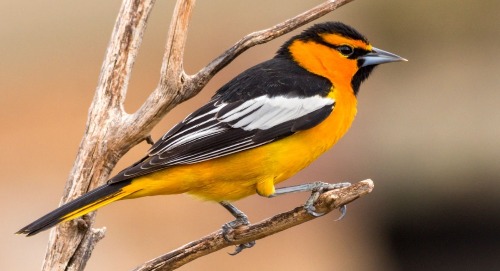
It's another black bird with an orange head and belly, a black back with white wing patches, a black throat, and black lines from the bill to the nape. A female Bullock's oriole has grayish and orange plumage.
It's the same size as the bird above, and you'll also see it in open woodlands and backyards. The first place to look for it is in cottonwoods. Do you have such open woodlands near you?
Further, Bullock's oriole hangs around nectar feeders waiting for sumptuous sugar water.
It winters in Mexico and breeds in the western states, so you're likely to see it in New Mexico, Colorado, Oregon, and California.
Fortunately, both sexes sing; therefore, listen for whistles and chatters.
Fun Fact: Some species on this list could pass for birds with orange chest like the Americna Robin, Western Bluebird, and Baltimore Oriole, to name a few!
4. Black-headed Grosbeak

You may notice its thick bill before you even marvel at the orange-cinnamon underbelly and black and white wings. The female bird flaunts warm orange on its breast.
Like the bird above, this one will also have you touring western states as that's where it lives, in woodlands and forest edges. Its favorites are habitats with large trees and a rich understory.
This love for understory will have you exploring foliage as that's where the black headed grosbeak finds insects and seeds. But, if you live in its range in the western states, you can install a backyard feeder to offer sunflower seeds. It's also curious about nectar feeders.
This songbird is larger than a house finch as its length measures 7.1 to 7.5 inches.
5. Western Tanager
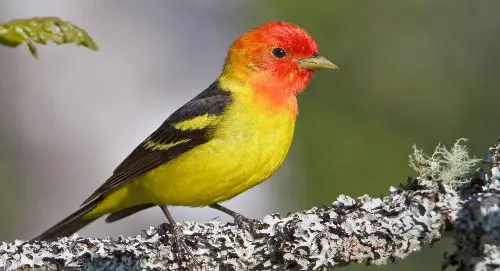
It's a medium-sized bird with a length between 6.3 and 7.5 inches, flaunting a yellow body, black wings with white wing bars, and an orange-red head. However, a female bird has a yellowish body.
Fun Fact: Many yellow-bellied birds have become the favorite among avian enthusiasts in the USA!
This songbird inhabits the Pacific Northwest; consequently, you'll see it in California and northern Mexico, among other parts of North America.
So, where should you go looking for western tanagers? First, try the forests near water bodies. You'll have to look for them in the canopies. Their breeding range is in coniferous or mixed woodlands, and they nest in pine or cacti trees. Sometimes, these birds use the nests of sparrows and chickadees.
You should see them hunting insects or picking fruits and berries while hopping from tree branches. They get a red pigment from eating insects.
If you have a bird feeder, you can attract a western tanager with fruits, such as orange slices.
6. Varied Thrush
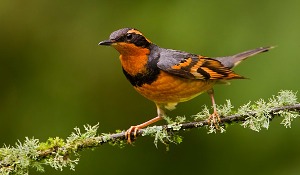
It's between 7.5 and 10.2 inches long, so it's the size of a hairy woodpecker.
A varied thrush has a blue-gray back, an orange underbelly, plus an orange line above the eye. A female bird has brownish feathers above and a burnt orange underbelly, eyebrow, and wing bars.
It's a ground-hopping bird that you'll also see in low shrubs looking for insects. Nevertheless, it eats fruits and berries in winter.
You'll see this short-distance migrant on the western edge of North America from Alaska to California. Its breeding range is in mixed forests and the understory of evergreens on the Pacific coast.
7. Orchard Oriole

It's on this list because of its reddish-orange belly, black back, and black head. But, we're only talking about the male here as a female orchard oriole has a greenish-yellow body, and its underbelly is pale.
As for its body measurements, you'll be looking for a rusty blackbird that's between 5.9 and 7.1 inches long. If you have seen an American goldfinch, this one is larger.
It's not a native of the whole continent as its breeding range is in the central and eastern states while its wintering grounds are south towards Central America. If you visit any of these regions, look for the orchard oriole in open woodland or shrublands. It also loves river banks like the great blue heron.
Lastly, nectar feeders can bring them to your backyard.
8. American Redstart

This warbler is the size of an American goldfinch as its length is 4.3 to 5.1 inches. But, you can never confuse the two since a redstart is a black bird with orange on the wings, tail, and sides while a goldfinch has yellow plumage.
Fun Fact: Goldfinches in Texas are just as plentiful in the states of New Jersey, Iowa, and Washington and equally adorable as the hummingbirds, woodpeckers, and cardinals!
This insectivore is always up and about catching insects in open woodlands. It's a long-distance migrant with two breeding ranges: the birds in the eastern states migrate to Florida and South America, and those breeding in central and western North America fly south to Mexico and Central America.
You'll welcome redstarts to your backyard with serviceberry and magnolia thickets as they love these berries.
9. Eastern Towhee

This sparrow is smaller than a robin but larger than a house sparrow as it grows between 6.8 and 8.2 inches long.
We put it on this list for its black back and head, plus reddish-orange sides. However, the female birds have brown heads and backs.
An eastern towhee is a resident in southeastern states. It may migrate from Virginia to winter in south Texas.
This sparrow loves undergrowth in forest edges and thickets. You'll see it opting for fallen seed under your feeder. But, it'll also enjoy sunflower seeds or cracked corn offered on a platform feeder.
It's an entertaining bird that'll fill the air with a chewink song.
10. American Robin

It's one species that almost every birder sees in the first months of taking up the hobby. It's everywhere in the US as it's a resident bird. An American robin measures 7.9 and 11.0 inches long, so it's about half the size of a pileated woodpecker.
This short-distance migrant breeds in Canada and other northern regions before migrating to the US or wintering south in Mexico and Florida. It inhabits different places from woodlands to parks and fields with earthworms or insects.
This orange and black bird visits backyards across the states, foraging earthworms in spring.
Fun Fact: Robins are considered wild birds and one way of attracting these backyard visitors to your feeder is by giving them the best wild bird seed mix.
11. Hooded Oriole

It has a yellow or orange body, a black throat, and white wing bars. However, that's one sex because a female oriole has an olive-yellow underbelly, gray back, and white, thin wing bars.
The male birds in Texas have orange plumage, but those inhabiting western states are yellow. It doesn't migrate a long distance as its breeding range is around California, while wintering grounds are in Mexico.
The Cornell Lab notes that a hooded oriole is a forager that often hangs upside down to grab its prey. To see it, explore open woodlands with scattered palm trees or cottonwoods. Like other orioles, it builds a hanging nest using plant fiber and grass.
You'll be looking for a bird that's between 7.1 and 7.9 inches long.
12. Spotted Towhee
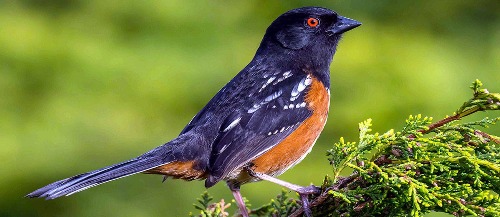
You'll tell the male and female birds apart by their backs and throats as the males are black while the females are brown. However, they both have orange-brown sides, white wing bars, and white bellies.
This bird species measures 6.7 to 8.3 inches long, so it's smaller than a robin and almost the size of an eastern bluebird.
It's a resident in the western states, and it migrates a short distance from the northwestern region of North America to winter south in Texas and Mexico.
You can attract a spotted towhee to your backyard if there are brushy or shrubby areas. Pour sunflower seeds or millet on the ground.
13. Barn Swallow
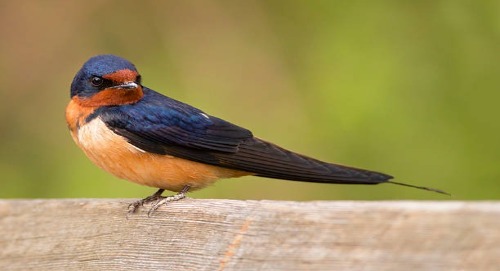
Unlike most birds we've talked about so far, the barn swallow has a breeding range throughout North America. Thus, it's a long-distance migrant that winters in Central and South America.
If there's a swallow on your property, then you'll notice a cup-shaped mud nest in your outbuilding. It doesn't eat seed or suet, but it may enjoy eggshells offered on a platform feeder.
An unmated male bird can win over the female of a nesting pair by killing the nestlings. Wild! We haven't mentioned the ID details of this swallow.
So, look for a sparrow-sized bird with pointed wings, blue upper parts, a rusty forehead, and a tawny underbelly.
14. Blackburnian Warbler

Like most birds on this list, both sexes have different feathers. A female bird is more yellowish, whereas the other sex has an orange throat and face, black back and wings, and a white belly with black streaks.
It's a rather small bird, though not as small as a rufous hummingbird, as it grows between 4.3 and 4.7 inches long. You'll see it in the eastern states during its migration from Canada to wintering grounds in South America.
Frequently Asked Questions
What is the difference between a Baltimore Oriole and an orchard oriole?
An orchard oriole is smaller as it’s between 5.9 and 7.1 inches long from the bill to the tail, whereas a Baltimore oriole measures 6.7 and 7.5 inches long. Furthermore, an orchard's underbelly has chestnut plumage, whereas a male Baltimore has bright orange feathers.
When you compare their habitats, a Baltimore can nest in open areas or farm fields, whereas an orchard prefers young woods in forest edges to backyards or parks.
What's the difference between a crow and a blackbird?
Since there are many species of blackbirds, we can only talk about them in general and focus on the ID details of the crow. First, the location can tell you if you're looking at a crow or a blackbird. Crows are everywhere, but some species of blackbirds, such as the red-winged, breed in Canada and Alaska.
The calls and songs also differ, with the crow producing a distinct caw. Other physical characteristics are the black eyes of crows and their arched bills.
Plumage color isn't a good ID detail when comparing these two species as only the males have colorful feathers.
Conclusion
You know, birding is all about discovering species. Taking up the challenge to look for an orange bird with black wings will have you exploring different states across the US. From our discussion above, it's clear that you'll see some species in eastern states and others in western states.
How exciting would it be to start your birding tour in California and conclude your sightings with some pictures of eastern towhees spotted in Florida? Imagine that!

